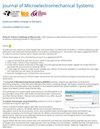基于 PZT 的 PMUT 的特征描述和优化与宽频调谐
IF 3.1
3区 工程技术
Q2 ENGINEERING, ELECTRICAL & ELECTRONIC
引用次数: 0
摘要
本文介绍了空气耦合锆钛酸铅(PZT)压电微机械超声换能器(PMUT),该换能器通过直流偏置电压产生的可控面内应力实现了超宽频率调谐范围。设计谐振频率为 ~200kHz 的 PMUT 在 ±35V 直流偏压下产生了 223kHz 的总频率偏移,从 182.5kHz 到 405.5kHz(相当于无偏压时谐振频率的 97.8% 变化),在 ±10V 直流偏压下产生了 124kHz 的频率偏移,从 188kHz 到 312kHz(相当于 54.4% 变化)。通过阻抗分析仪和激光多普勒测振仪(LDV)进一步表征了直流偏压调谐的效果,成功观测到了机电耦合系数(${k}_{mathrm {t}}^{\mathrm {2}}$)的波动和压电层极化方向的变化。研究了沿磁滞环不同曲线的频率调谐,并给出了合理的 ${k}_{mathrm {t}^{mathrm {2}}$ (1\sim 6$ V 直流偏压是从磁滞环的最佳选项中选择的)。此外,还研究并总结了不同顶电极厚度的 PMUT 的特性,并考虑采用更薄的顶电极作为优化方法,使直流偏压下的 PMUT 在频率调谐方面获得更好的性能。对不同频率的 PMUT 进行了评估,测量结果表明,由于膜模量不同,共振频率较高的 PMUT 的调谐范围小于共振频率较低的 PMUT,因此直流偏压产生的内在应力对整个膜模量的贡献也不同。[2024-0036]本文章由计算机程序翻译,如有差异,请以英文原文为准。
Characterization and Optimization of PZT-Based PMUTs With Wide Range Frequency Tuning
In this paper, we present air-coupled lead-zirconate-titanate (PZT) piezoelectric micromachined ultrasonic transducers (PMUTs) which demonstrate ultra-wide frequency tuning range via controllable in-plane stress generated by DC bias voltage. A PMUT designed to have a resonant frequency of ~200kHz generates a 223kHz total frequency shift from 182.5kHz to 405.5kHz with ±35V DC bias (corresponding to 97.8% variation referring to the resonant frequency without bias), and a 124kHz frequency shift from 188kHz to 312kHz with ±10V DC bias (corresponding to 54.4% variation). The effects of DC bias tuning were further characterized by both impedance analyzer and laser Doppler vibrometer (LDV), the fluctuation of electromechanical coupling coefficient (
${k}_{\mathrm {t}}^{\mathrm {2}}$
) and the change of the direction of polarization of the piezoelectric layer were successfully observed. Frequency tuning along different curves of the hysteresis loop was studied, and given both reasonably good
${k}_{\mathrm {t}}^{\mathrm {2}}$
(<5%)> $1\sim 6$
V DC bias is chosen from the best option of the hysteresis loop. Furthermore, characteristics of PMUTs with different top electrode thickness were studied and summarized, and thinner top electrode was considered as an optimization method to achieve better performance for PMUT under DC bias in terms of frequency tuning. PMUTs with various frequencies were evaluated, and measurement results show a smaller tuning range of PMUTs with higher resonant frequency than those with lower resonant frequency due to the different membrane modulus, and, therefore different contributions of intrinsic stress generated by DC bias to the overall membrane modulus. [2024-0036]
求助全文
通过发布文献求助,成功后即可免费获取论文全文。
去求助
来源期刊

Journal of Microelectromechanical Systems
工程技术-工程:电子与电气
CiteScore
6.20
自引率
7.40%
发文量
115
审稿时长
7.5 months
期刊介绍:
The topics of interest include, but are not limited to: devices ranging in size from microns to millimeters, IC-compatible fabrication techniques, other fabrication techniques, measurement of micro phenomena, theoretical results, new materials and designs, micro actuators, micro robots, micro batteries, bearings, wear, reliability, electrical interconnections, micro telemanipulation, and standards appropriate to MEMS. Application examples and application oriented devices in fluidics, optics, bio-medical engineering, etc., are also of central interest.
 求助内容:
求助内容: 应助结果提醒方式:
应助结果提醒方式:


